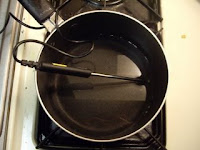Welcome to the age of technology. Since entering this era, technology
has become more readily accessible to both teachers and students. Teachers now have the opportunity to allow students to discover
science on a first-hand basis rather than relying on the experiences
of others. With the advantage of technological software and hardware,
learning becomes more meaningful, appeals to different types of
learners, and reinforces the concepts being taught.We took advantage of such technology by including it in the experiment
we carried out to introduce the concept of physical changes of matter and how temperature affects the states of matter. We decided to begin
with the most familiar substance: water.

To display these changes, we
began with a pot of frozen water. Using the digital temperature probe, we simply connected its USB cord into the computer and placed
the probe into the pot of ice in order to calculate and record the current temperature of the ice.

Leaving the probe in the pot of ice, we then increased the temperature of the burner.

As the probe records
the increase in temperature by graphing it on the computer, we observed how the water transformed from a solid to a liquid state.

Increasing the temperature of the burner yet again, we left the probe
in the pot to continue recording the changes in temperature of the
water.

We noticed the physical change of matter as the liquid transformed into its final state, a gas.

We concluded
the experiment by observing the graph on the computer and analyzing
the correlation between the increase in temperature and each physical
state of water.
Although basic experiments, like the one we accomplished, can be
performed in the classroom in old school fashion, technology like the
portable, digital probe provides more accurate data, graphs changes in
temperature in real time and exposes students to the limitless
possibilities technology has to offer. Furthermore, with the
supplement of this particular technology, students are learning how to
observe a set of data as well as analyze, identify, and describe the
relationships involved with temperature and physical states of matter
as shown on graphs.
